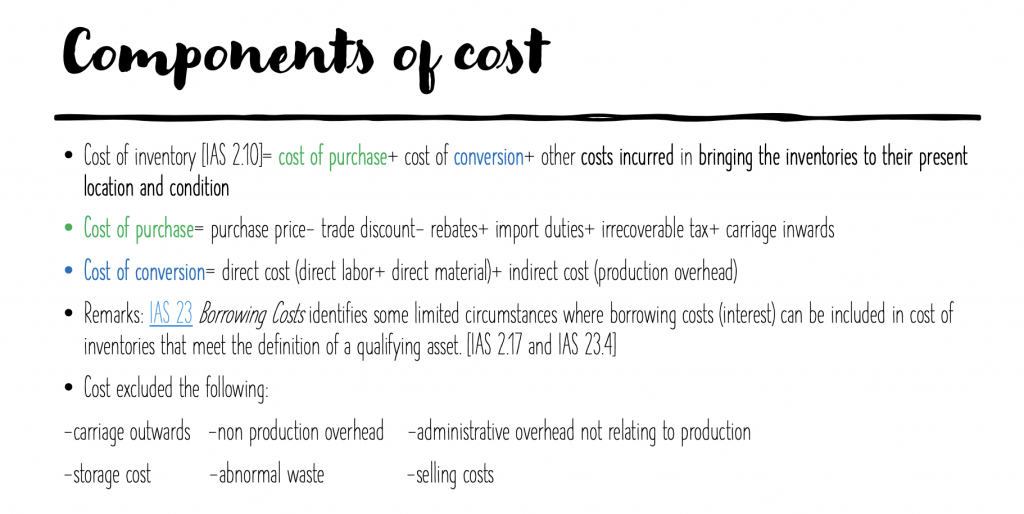IAS 2 on Inventories
Summary:
- Definition [IAS 2.6]:
- Inventories are assets held for sale in regular business, in production for such sales, or as materials to be consumed in production or service provision.
- Examples include raw materials, work in progress, finished goods, and goods for resale.
- Measurement:
- Inventories are valued at the lower of cost and net realizable value.
- Components of Cost:
- Inventory cost = cost of purchase + cost of conversion + other associated costs.
- Exclusions from cost: carriage outwards, non-production overhead, administrative overhead unrelated to production, storage cost, abnormal waste, and selling costs.
- Certain borrowing costs may be included under specific conditions.
- Net Realizable Value (NRV):
- NRV is the estimated selling price minus estimated completion and sales costs.
- Write-downs to NRV are recorded as an expense, and reversals are noted in the income statement.
- Reasons for write-downs include damaged or obsolete goods or increased costs/fallen sales prices.
- Double Entry for Write Down:
- Sale of inventories: Dr Cost of Sales (COS) Cr. Inventory
- Write-down of inventory: Dr COS Cr. Inventory/Inventory allowance
- Reversal of write-down: Dr Inventory/Inventory allowance Cr. COS
- Pricing Method:
- FIFO: Earliest inventory items are sold first.
- Weighted Average Cost: Average cost determined from similar items over the period.
- LIFO: Not allowed under IAS 2.
- Spare Parts:
- Classified either under Inventories (IAS 2) or PPE (IAS 16) based on usage and duration.
- Depreciation charges vary based on the immediate or delayed use of the spare parts.
- Receipt of Free Assets:
- Received from government, supplier, customer, shareholders, or others.
- Treatment varies based on the source and conditions attached, often recorded at Fair Value.
- Account within the Context of a Contract:
- Deals with non-cash considerations, and allocation principles are applied based on contract specifics.
- Discounts:
- Varies based on perspective (buyer or seller).
- Treatment depends on the reason for the discount, such as a settlement or a sales strategy like “Buy 1 Get 1 Free”.
Excerpt:
IAS 2 on Inventories
Definition [IAS 2.6]:
- Inventories are assets:
- Held for sale in the ordinary course of business
- In the process of production for such sale
- In the form of materials or supplies to be consumed in the production process or in the rendering of services – Eg: Raw material, work in progress, Finished Goods, Goods for resale (trading)


Reviews